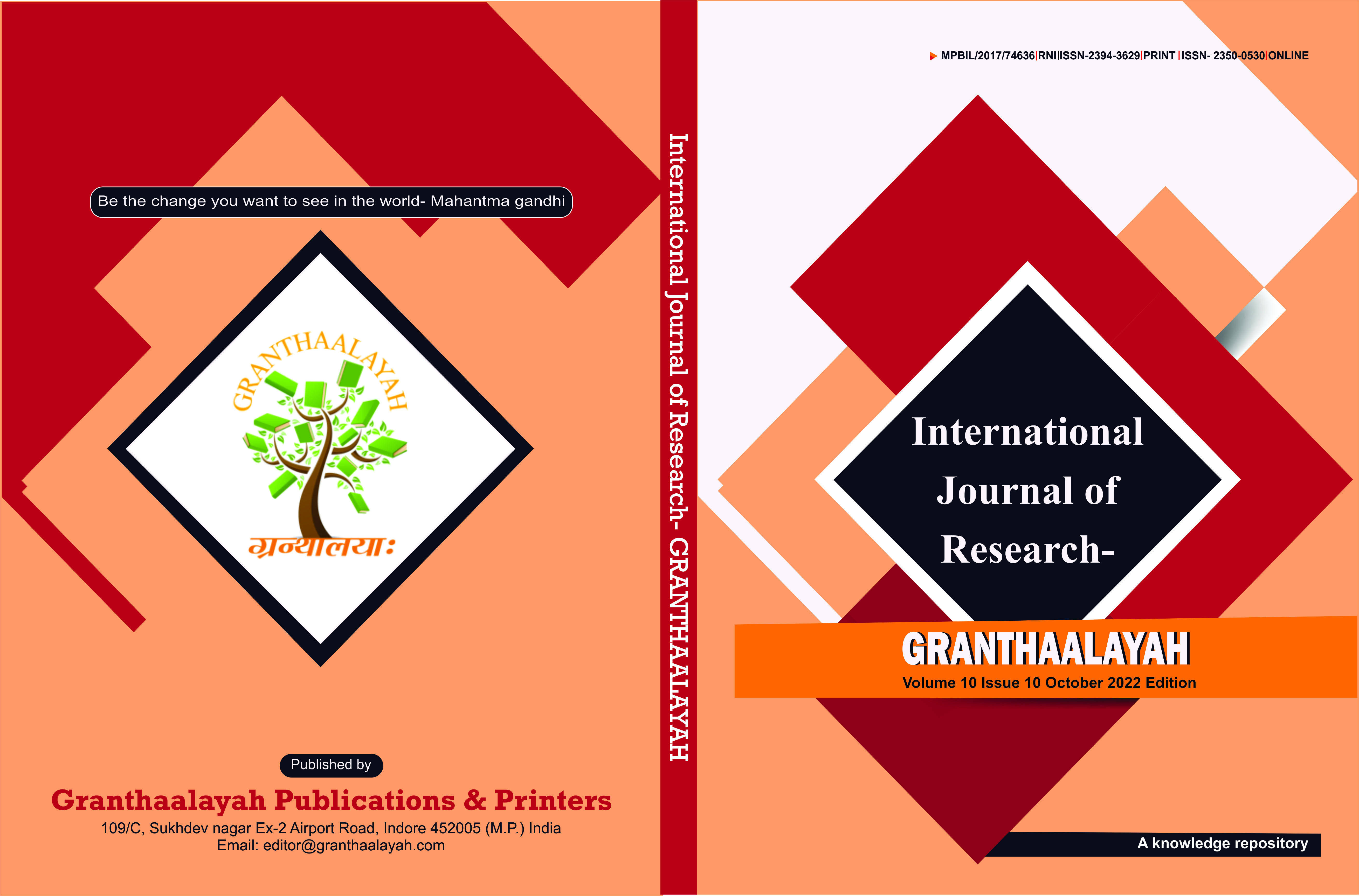LDPE DEGRADING ABILITY OF RIEMERELLA STRAIN ISOLATED FROM THE GARBAGE DUMPING SITES OF VISAKHAPATNAM, INDIA
DOI:
https://doi.org/10.29121/granthaalayah.v10.i10.2022.4843Keywords:
LDPE, Riemerella Sp., Gen III Biolog, Biodegradation, Weight LossAbstract [English]
Polyethylene is found to accumulate in the environment, posing a major ecological threat. Affordable and environmentally friendly treatments are need of the hour to combat this plastic pollution. A study was made to isolate microorganisms from a sample of garden soil and evaluate their degrading potential. The plastic sample tested in this study were Low Density Polyethylene shopping carry bag. The growth of LDPE degrading strains was carried out in Mineral salt agar medium with LDPE as the sole carbon and energy source. Six strains were isolated. One of the strains namely A3 was found to show maximum growth rate. It was known that LDPE is resilient to biodegradation. Nevertheless, the present work shows the utilization of LDPE by A3 strain as carbon source and indicates that microbes are familiarizing towards hydrocarbons. The phenotypic fingerprint like Gen III biolog was used to actuate the substrate utilization of strain A3 and identified it as, Riemerella anatipestifer. Preliminary growth studies were carried out initially. The optimal conditions were found to be pH of 7.1, temperature of 37ᵒC, contact time of 72hrs, LDPE weight of 0.042g and inoculums volume of 3v/v. LDPE degradation was confirmed by the weight loss which was found to be 20.09% after an incubation of 35 days. As per our work we found that, garden soil is a good source of bacteria that can degrade LDPE. These results also signify the potential of novel strain Riemerella Sp. to degrade LDPE films. This manuscript will pave the way for future studies on biodegradation.
Downloads
References
Alshehrei, F., (2017). Biodegradation of Synthetic And Natural Plastic By Microorganisms. Journal of Applied and Environmental Microbiology, 5 (1), 8-19.
Andrady, A.L., and Neal, M.A., (2009). Applications and societal benefits of plastics. Philosophical Transactions of the Royal Society B: Biological Sciences, 364, 1977-1984. https://doi.org/10.1098/rstb.2008.0304. DOI: https://doi.org/10.1098/rstb.2008.0304
Benachour, N., and Aris, A., (2009). Toxic Effects of Low Doses Of Bisphenol-A on Human Placental Cells. Toxicol Appl Pharmacol, 241(3), 322-328. https://doi.org/10.1016/j.taap.2009.09.005. DOI: https://doi.org/10.1016/j.taap.2009.09.005
Chaturvedi, B. and Chintan., (2002). Imports Versus Surplus : A Glut of Plastics in India Today. No Plastics in the Environment (NoPE). Environmental Organisation, New Delhi.
Gray, J., Evans, N., Taylor, B., Rizzo, J.J., and Walker, M., (2009). State of the Evidence : The Connection Between Breast Cancer and the Environment. Int J Occu Environ Heal, 15(1), 43-78. https://doi.org/10.1186/s12940-017-0287-4. DOI: https://doi.org/10.1179/oeh.2009.15.1.43
Hao, J., Wang, J., Zhao, W., Ding, L., Gao, E.,Yuan, W., and Wei, S. Y. J., (2011). Effect of Bisphenol A Exposure on Sex Hormone Level In Occupational Women. 40(3), 312- 214.
Howard, G.T. (2002). Biodegradation of Polyurethane: A Review. Int Biodeterior Biodegrad. 49, 245-252. https://doi.org/10.1016/S0964-8305(02)00051-3. DOI: https://doi.org/10.1016/S0964-8305(02)00051-3
Ishigaki, T., Sugano, W., Nakanishi, A., Tateda, M., Ike, M. and Fujita, M. (2004). The Degradability of Biodegradable Plastics in Aerobic and Anaerobic Waste Landfill Model Reactors. 54(3), 0-233. https://doi.org/10.1016/S0045-6535(03)00750-1. DOI: https://doi.org/10.1016/S0045-6535(03)00750-1
Lyon, F., (2011). Agents Classified by the IARC Monographs. World Health Organization. IARC (International Agency for The Research on Cancer), 321.
Pilz, H., Brandt, B., and Fehringer, R., (2010). The Impact of Plastics on Life Cycle Energy Consumption and Greenhouse Gas Emissions in Europe Summary Report. Vienna, Austria. Denkstatt Gmbh.
Plastics Europe., (2015). Business data and charts 2013/2014. Plastics Europe. Brussels.
Punny, K., Divya Teja, D., and Sridevi, V. (2018). A Review On Microbial Identification System-Gen III Micro-Log, A Unique Metabolic Finger-Print For Identification Of Phenol Degrading Bacteria. Int J Pharma Bio Sci, 9(2),334-339. http://dx.doi.org/10.22192/ijarbs.2020.07.06.014. DOI: https://doi.org/10.22376/ijpbs.2018.9.2.b334-339
Raziyafathima, M., Praseetha, P. K., and Rimal Isaac, R. S., (2016). Microbial Degradation of Plastic Waste : A Review. Journal of Pharmaceutical, Chemical and Biological Sciences, 4(2), 231-242.
Rudel, R. A., Attfield, R.K., Schifano, J.N., and Brody, JG., (2007). Chemicals Causing Mammary Gland Tumors in Animals Signal New Directions for Epidemiology, Chemicals Testing and Risk Assessment for Breast Cancer Prevention Cancer, 109(1), 2635-2666. https://doi.org/10.1002/cncr.22653. DOI: https://doi.org/10.1002/cncr.22653
Shimao, M., (2001). Biodegradation of Plastics. Current Opinion in Biotechnology 2001. https://doi.org/10.1016/S0958-1669(00)00206-8 DOI: https://doi.org/10.1016/S0958-1669(00)00206-8
Vatseldutt, and Anbuselvi, S., (2014). Isolation and Characterization of Polythene Degrading Bacteria from Polythene Dumped Garbage. Int J Pharm. 25(2), 205-206.
Published
How to Cite
Issue
Section
License
Copyright (c) 2022 Husam Talib Hamzah, Sridevi Veluru, Rishi Mallisetty, Sai Spandana Bandi, Venkata Rao Poiba, R. Srikanth

This work is licensed under a Creative Commons Attribution 4.0 International License.
With the licence CC-BY, authors retain the copyright, allowing anyone to download, reuse, re-print, modify, distribute, and/or copy their contribution. The work must be properly attributed to its author.
It is not necessary to ask for further permission from the author or journal board.
This journal provides immediate open access to its content on the principle that making research freely available to the public supports a greater global exchange of knowledge.

























